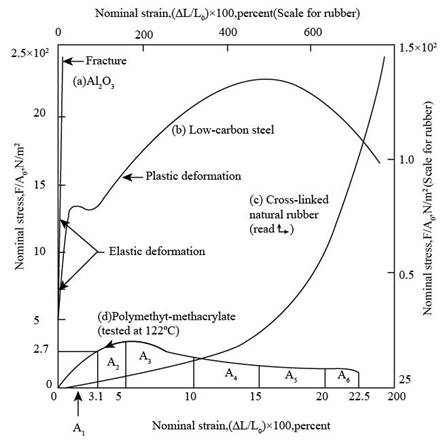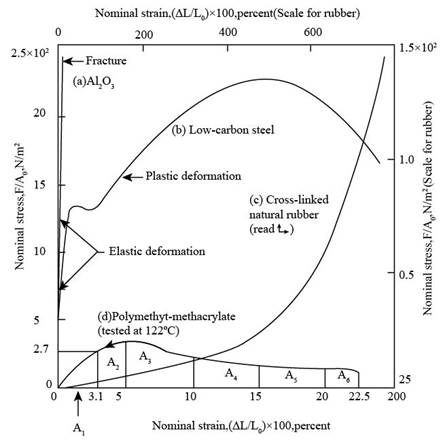
Concept explainers
(a)
The tangent elastic modulus.
(a)
Answer to Problem 6.19P
The tangent elastic modulus at zero strain is
Explanation of Solution
Formula Used:
Write the expression for the tangent elastic modulus.
Here,
Calculation:
Refer Figure 6.16 “Tensile stress-strain diagram for four different type of materials” from the book “Material Science and Engineering Properties”.
The value of change is stress for PMMA is
Substitute
Conclusion:
Thus, the tangent elastic modulus at zero strain is
(b)
The yield stress of PMMA.
(b)
Answer to Problem 6.19P
The yield stress for PMMA is
Explanation of Solution
Calculation:
Refer Figure 6.16 “Tensile stress-strain diagram for four different type of materials” from the book “Material Science and Engineering Properties”.
The tensile stress diagram for PMMA is shown in figure below.

Figure (1)
The value of the yield stress for PMMA is
Conclusion:
Thus, the yield stress for PMMA is
(c)
The resilience of PMMA.
(c)
Answer to Problem 6.19P
The resilience of PMMA is
Explanation of Solution
Formula Used:
Write the expression for the resilience.
Here,
Calculation:
Substitute
Conclusion:
Thus, the resilience of PMMA is
(d)
The ultimate tensile strength of PMMA.
(d)
Answer to Problem 6.19P
The ultimate tensile strength for PMMA is
Explanation of Solution
Calculation:
The ultimate tensile strength in a stress-strain diagram is obtained by observation of the highest point that is reached by the curve after which the necking of curve starts.
Refer Figure 6.16 “Tensile stress-strain diagram for four different type of materials” from the book “Material Science and Engineering Properties”.
The value of the ultimate tensile strength for PMMA is
Conclusion:
Thus, the ultimate tensile strength for PMMA is
(e)
The toughness of PMMA.
(e)
Answer to Problem 6.19P
The toughness of PMMA is
Explanation of Solution
Formula Used:
Write the expression for the first area.
Here,
Write the expression for the second area.
Here,
Write the expression for the third area.
Here,
Write the expression for the fourth area.
Here,
Write the expression for the fifth area.
Here,
Write the expression for the sixth area.
Here,
Write the expression for the toughness of specimen.
Calculation:
Refer Figure 6.16 “Tensile stress-strain diagram for four different type of materials” from the book “Material Science and Engineering Properties”.
The stress strain diagram for PMMA with sub-divided area is shown below,

Figure (2)
Substitute
Substitute
Substitute
Substitute
Substitute
Substitute
Substitute
Conclusion:
Thus, the toughness of PMMA is
Want to see more full solutions like this?
Chapter 6 Solutions
Materials Science And Engineering Properties
- The data in Table 1.5.3 were obtained from a tensile test of a metal specimen with a rectangular cross section of 0.2011in.2 in area and a gage length (the length over which the elongation is measured) of 2.000 inches. The specimen was not loaded to failure. a. Generate a table of stress and strain values. b. Plot these values and draw a best-fit line to obtain a stress-strain curve. c. Determine the modulus of elasticity from the slope of the linear portion of the curve. d. Estimate the value of the proportional limit. e. Use the 0.2 offset method to determine the yield stress.arrow_forwardThe results of a tensile test are shown in Table 1.5.2. The test was performed on a metal specimen with a circular cross section. The diameter was 3 8 inch and the gage length (The length over which the elongation is measured) was 2 inches. a. Use the data in Table 1.5.2 to produce a table of stress and strain values. b. Plot the stress-strain data and draw a best-fit curve. c. Compute the, modulus of elasticity from the initial slope of the curve. d. Estimate the yield stress.arrow_forwardCompare the engineering and true secant elastic moduli for the natural rubber in Example Problem 6.2 at an engineering strain of 6.0. Assume that the deformation is all elastic.arrow_forward
- X Your answer is incorrect. An extruded polymer beam is subjected to a bending moment M. The length of the beam is L = 620 mm. The cross-sectional dimensions of the beam are b1 = 39 mm, d1 = 82 mm, b2 = 23 mm, dɔ = 23 mm, and a = 8 mm. For this material, the allowable tensile bending stress is 20 MPa, and the allowable compressive bending stress is 12 MPa. Determine the largest moment M that can be applied as shown to the beam. b2 a d2 y A B b1 Answer: M = 412.360 N•m Attempts: 2 of 3 usedarrow_forwardAn extruded polymer beam is subjected to a bending moment M. The length of the beam is L = 900 mm. The cross-sectional dimensions of the beam are b1 = 37 mm, d1 = 88 mm, b2 = 22 mm, d2 = 22 mm, and a = 7.5 mm. For this material, the allowable tensile bending stress is 18 MPa, and the allowable compressive bending stress is 14 MPa. Determine the largest moment M that can be applied as shown to the beam.arrow_forwardAn extruded polymer beam is subjected to a bending moment M. The length of the beam is L = 580 mm. The cross-sectional dimensions of the beam are b1 = 33 mm, d1 = 112 mm, b2 = 20 mm, d2 = 20 mm, and a = 6.5 mm. For this material, the allowable tensile bending stress is 15 MPa, and the allowable compressive bending stress is 13 MPa. Determine the largest moment M that can be applied as shown to the beam. b2 a a M d2 A B bịarrow_forward
- An extruded polymer beam is subjected to a bending moment M. The length of the beam is L = 500 mm. The cross-sectional dimensions of the beam are b₁ = 38 mm, d₁ = 82 mm, b₂ = 23 mm, d₂ = 23 mm, and a = 7.5 mm. For this material, the allowable tensile bending stress is 14 MPa, and the allowable compressive bending stress is 12 MPa. Determine the largest moment M that can be applied as shown to the beam. b₂ a M d₁ B L N-m | A Answer: M= d₂ b₁arrow_forwardAn extruded polymer beam is subjected to a bending moment M. The length of the beam is L = 620 mm. The cross-sectional dimensions of the beam are b1 = 32 mm, d1 = 117 mm, b2 = 19 mm, d2 = 19 mm, and a = 6.5 mm. For this material, the allowable tensile bending stress is 13 MPa, and the allowable compressive bending stress is 13 MPa. Determine the largest moment M that can be applied as shown to the beam. b2 a M | A Вarrow_forwardAn extruded polymer beam is subjected to a bending moment M. The length of the beam is L = 500 mm. The cross-sectional dimensions of the beam are b, = 35 mm, d = 115 mm, b2 = 21 mm, d, = 21 mm, and a = 7 mm. For this material, the allowable tensile %3D %3D bending stress is 15 MPa, and the allowable compressive bending stress is 14 MPa. Determine the largest moment M that can be applied as shown to the beam. b2 立 a 不 d2 d1 A Answer: N.m M= i Submit Answer Attempts: 1 of 3 usedarrow_forward
- An element in plane stress is subjected to stresses o, = -8400 psi, ay = 1100 psi, and ty = 1700 psi (see figure). The material is aluminum with %3D modulus of elasticity E =10,000 ksi and Poisson's ratio v = 0.33. Determine the following quantities: (a) the strains for an element oriented at an angle 30 degrees, (b) the principal strains, and (c) the maximum shear strains. Show the results on sketches of properly oriented elements. Ty Txy Oxarrow_forwardAn extruded polymer beam is subjected to a bending moment M. The length of the beam is L = 560 mm. The cross-sectional dimensions of the beam are b1 = 32 mm, d1 = 118 mm, b2 = 19 mm, d2 = 19 mm, and a = 6.5 mm. For this material, the allowable tensile bending stress is 14 MPa, and the allowable compressive bending stress is 13 MPa. Determine the largest moment M that can be applied as shown to the beam. b2 a M d2 | A В b1 Answer: M = i N-marrow_forwardIf Poisson's ratio is 0.42, the Modulus of rigidity is 70.4225 GPa, and the bulk modulus is 416.66 GPa, then the elastic modulus of elasticity is (3 Points) 300 GPa 300 MPa 200 MPa None 200 GPaarrow_forward
 Materials Science And Engineering PropertiesCivil EngineeringISBN:9781111988609Author:Charles GilmorePublisher:Cengage Learning
Materials Science And Engineering PropertiesCivil EngineeringISBN:9781111988609Author:Charles GilmorePublisher:Cengage Learning Steel Design (Activate Learning with these NEW ti...Civil EngineeringISBN:9781337094740Author:Segui, William T.Publisher:Cengage Learning
Steel Design (Activate Learning with these NEW ti...Civil EngineeringISBN:9781337094740Author:Segui, William T.Publisher:Cengage Learning

